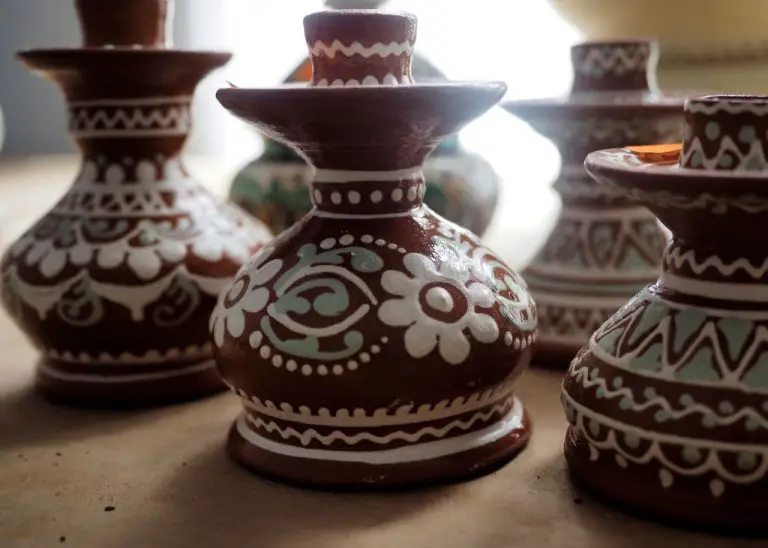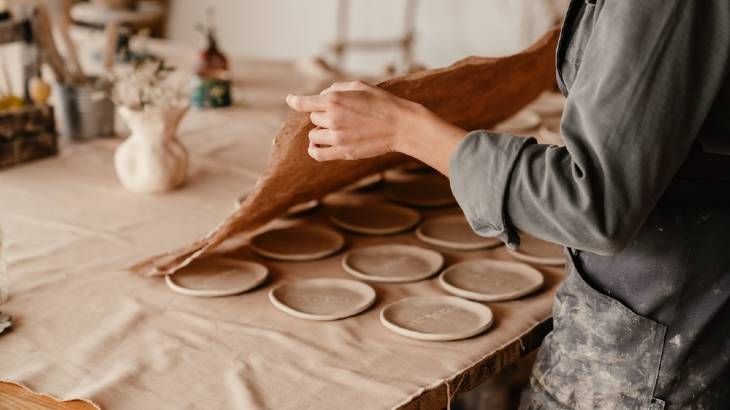How Do You Cleanly Cut Clay?
Cutting clay cleanly is an important skill for any clay artist or crafter. When cutting clay, the goal is to get smooth, even edges without distorting the shape or material. A clean cut will lead to a more professional looking finished product, while ragged or uneven edges can detract from the overall look. Beyond aesthetics, clean clay cuts are important for getting pieces to fit together properly and minimizing cracking or weak spots after baking. With the right tools and techniques, cutting clay cleanly is easy to achieve. This guide will cover everything needed to master clean clay cutting, from choosing the right blade or wire to proper baking methods for finished pieces.
Gather Supplies
Before cutting your clay, gather the necessary supplies to ensure a clean cut. The essential tools for cutting polymer clay cleanly include:
- Clay cutting wire – This thin wire easily cuts through clay without dragging or distorting the shape. Choose an aluminum or steel wire.
- Razor blade – A sharp razor or craft blade provides precise cuts. Opt for a sturdy metal blade instead of flimsy plastic.
- Ruler – A steel ruler with etched markings helps make straight cuts and evenly measured shapes.
- Self-healing mat – This provides a smooth cutting surface that protects your work surface.
Before starting any clay project, ensure you have these supplies ready to produce neat, clean cuts in your clay.
Prepare the Clay
Properly preparing your clay is an important first step to help ensure clean cuts. Start by conditioning your clay by kneading it vigorously with your hands until soft and pliable. This removes any air bubbles and allows the clay particles to bind together evenly. Use the heel of your hand to press firmly into the clay, then fold the clay over itself and continue kneading.
Once conditioned, roll out the clay with a rolling pin on a smooth, nonstick surface. Apply even pressure with the rolling pin to flatten the clay into a uniform thickness of about 1/4 inch. Thicker clay will be harder to cut cleanly, while thinner clay risks tearing or cracking. Check for smoothness by running your hand gently over the surface, and continue rolling until no bumps remain. Use rulers as guides to maintain straight edges. The even consistency allows clean lines when cutting shapes.
It’s crucial to properly prepare the clay before cutting for the best results. Taking the time to condition and roll out the clay eliminates variables that lead to rough or ragged cuts. Your conditioned, rolled clay will produce smooth, clean edges when cut.
Measure and Mark
Before making any cuts, it’s important to first measure and mark where you want to cut your clay. This will ensure your cuts are straight and even.
Use a ruler or measuring tape to determine where you want to make the cut. Mark the cut lines on the clay by pressing a tool into the surface. You can use a knife, skewer, toothpick or other pointed tool. Press firmly so the line is visible but be careful not to cut all the way through the clay.
Make sure to mark lines on the top and sides of the clay, so you can see where to cut from all angles. Having the cut lines marked ahead of time will serve as a guide as you make your cuts.
Marking straight lines will help give your clay project clean, precise cuts. Take the time to carefully measure and mark cut lines before slicing into the clay.
Cut with Wire
One of the most effective ways to cut clay cleanly is by using wire. The technique involves wrapping wire around the clay and pulling it through to slice the clay.
To start, gather a length of thin steel wire, such as a jeweler’s wire. The thinner the wire, the cleaner the cut will be. Make sure the wire is taut and straight.
Next, position the wire where you want to make the cut and press it gently into the surface of the clay to create a guide line. Wrap the ends of the wire around the clay, crossing them over to get a secure grip.
Hold the clay steady with one hand. With your other hand, quickly pull the wire ends to slice through the clay in one smooth, even motion. The wire should cut cleanly through the clay.
Repeat this process to make multiple cuts. Keep repositioning the wire and pulling in a rapid, straight motion for best results. Apply firm, even pressure so the wire passes through the clay without dragging or distorting the surface.
Cutting with wire takes practice but creates very smooth, precise cuts once mastered. It’s an ideal technique for intricate clay projects requiring detailed cuts and shapes.
Cut with Blade
Using a sharp blade or razor is an effective way to make clean cuts in clay. When cutting with a blade, hold the clay firmly on a flat surface and keep your non-cutting hand well out of the way. Position the blade right up against the edge of a ruler or template, holding it at a 45 degree angle. Apply firm, even pressure as you slice through the clay in one smooth motion. Keep the blade straight and don’t saw back and forth. Lift straight up after cutting to avoid dragging clay residue onto the cut edge.
Single-edged razor blades work very well for cutting clay as their sharp, fine edges provide precision. Replace the blade frequently as soon as it starts to drag or stick. For safety, always cut away from yourself and take care not to cut too deeply. Keep fingers away from the blade’s path and consider wearing cut-resistant gloves. Discard used blades properly.
With good technique, you can achieve straight cuts and clean edges. Avoid applying too much pressure or cutting too quickly, as this can distort or tear the clay. Patience and control pays off with neatly sliced clay ready for smoothing and baking.
Troubleshoot Issues
Even when taking precautions, you may encounter some problems when cutting clay. Here are some tips for troubleshooting:
Prevent Tearing
If the clay tears or rips while cutting, the blade you’re using is likely too dull. Switch to a new, sharp blade. Make sure to cut slowly and steadily. Avoid twisting or wiggling the blade. You can also try warming up the clay slightly before cutting to make it more malleable.
Fix Uneven Cuts
For straight cuts that end up uneven, use a metal ruler or square as a guide for your blade. Place the ruler where you want to cut and run the blade against it. For freehand cuts, focus on keeping the blade steady as you cut. Smooth any rough edges after cutting using a clay shaper tool.
Smooth Edges
Smoothing the edges of cut clay pieces helps create a polished, professional look for your finished pieces. There are a few techniques you can use to smooth rough cut edges of clay:
- Rub the edge – Rubbing the cut edge with your finger can help smooth out small irregularities. Apply firm but not too much pressure and run your finger back and forth along the edge.
- Use a clay shaping tool – Scraping cut edges with a dull clay shaping tool will shave down rough areas. Work slowly and carefully to avoid taking off too much clay.
- Sand the edge – Fine grit sandpaper can be used to smooth edges of baked clay. Wrap the sandpaper around a pencil or dowel and carefully rub along the edges.
- Apply liquid clay – Using a tiny amount of liquid clay on cut edges will help fill in gaps and create a smooth surface when baked.
Test different smoothing techniques on scrap pieces of clay to determine what works best for your project. Take care not to over-smooth or you may distort the shape of your clay work.
Bake Properly
After cutting your clay, it’s important to bake it properly in order to prevent deforming or damage to the finished piece. When baking cut clay, follow these guidelines:
- Refer to the clay manufacturer’s instructions for recommended baking times and temperatures. Polymer clay generally bakes at 265°F for 15 minutes per 1/4 inch of thickness.
- Bake in a dedicated polymer clay oven or toaster oven at the recommended temperature. Do not bake clay in a food oven.
- Place cut clay pieces on a baking sheet lined with parchment paper or aluminum foil.
- Avoid baking multiple stacked or touching pieces at once. Separate all cut edges so they don’t bond together.
- To prevent scorching, bake clay on the middle rack of the oven, not the top or bottom racks.
- After baking, allow the clay to cool completely before handling to prevent damaging soft clay.
Proper baking will harden and cure the clay fully, providing cleanly cut edges and preventing later issues. Always refer to the clay manufacturer’s advice when unsure of baking recommendations.
Create Clean Cuts
To create clean cuts when working with clay, there are a few key techniques to keep in mind.
First, always use sharp tools. Whether cutting with a wire tool or a blade, a sharp edge will slice smoothly through the clay and result in the least amount of drag or tearing. Make sure to replace any dull blades or wire.
Next, avoid handled tools where possible. Tools with handles attached mean your hand has to move across the clay surface as you cut, which can distort the clay. Handle-less blades allow you to hold your hands stable and draw the blade straight down through the clay for the cleanest cut.
Cut in a single motion when possible. Dragging the blade back and forth will tear the clay rather than slicing it cleanly. Apply firm, even pressure and cut down through the clay in one smooth, continuous movement.
Finally, make the cut at a 90 degree angle. Cutting straight down perpendicular to the surface will make the cleanest cut. Angle the blade slightly and you may drag across or tear the clay.
Following these guidelines will help you achieve smooth, professional cuts when working with clay, ensuring your projects have crisp edges and details.



